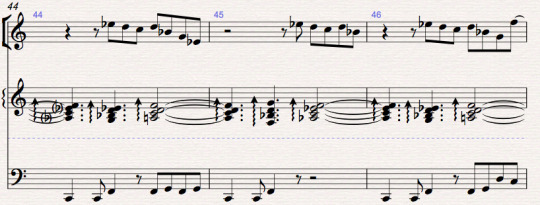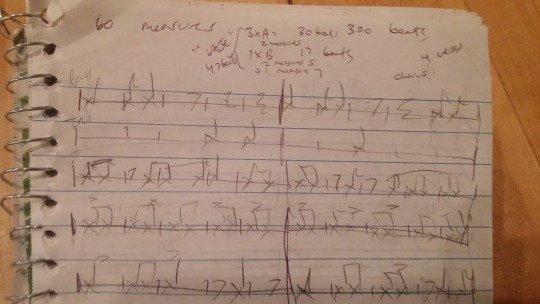Unsolicited Musings from a Sound Designer and Composer Living in New York
Don't wanna be here? Send us removal request.
Text
The Passing of Two Sonic Visionaries
Sad news in the worlds of classical music and film these past few days. Pierre Henry, pioneer of music concrète, and David Yewdall, Hollywood sound designer, have both passed away.
After studying under famed pedagogue Nadia Boulanger and composer Olivier Messiaen (one of my favorites), Pierre Henry took up residence with the Radiodiffusion-Télévision Française, a French public broadcasting organization that created the first studio dedicated solely to the composition of electroacoustic music. The works of music concrète composed there would go on to change the landscape of both electronic music and film sound, by introducing a wholly original sonic palette that can manipulate emotions and expectations in unexpected ways. Surely the iconic opening to Ingmar Bergman’s Persona owes a debt to the innovative work Henry and his colleagues were doing at the RTF:
youtube
David Yewdall’s work has captured my imagination since I was a child, although I certainly didn’t know it at the time. He worked as a sound editor on two of my favorite films: The Fifth Element and Starship Troopers, and is known for his relationship with John Carpenter, collaborating with him on several films, including the iconic The Thing. One of my favorite scenes from The Fifth Element contains a wealth of sonic information: the memorable heavy metallic clicks characterizing Zorg’s steps, the whizzes, whirrs, blurps and beeps of the ZF1, and the hilarious grunts of the Mangalores all contribute to the zany fun of the movie.
youtube
1 note
·
View note
Link
I’ve always wanted to visit an anechoic chamber. Maybe this’ll suffice.
0 notes
Text
¡Feliz Año Nuevo!
Whoa! I haven’t updated my blog in a while! Or my website. To be fair, I was pretty busy! I worked on my first feature, The Idea of Manhood, for which I was the production sound mixer and sound editor. I worked with a wide number of production companies and clients, including a video from Teen Vogue that went viral, and may have even influenced national policy. Best of all, I had the pleasure of traveling to Peru to work on a pilot for an upcoming travel web series ... oh and I moved to Brooklyn somewhere in there. It’s been nice unwinding for the holidays... but now it’s time to get back to work!
0 notes
Link
1 note
·
View note
Video
youtube
Dis I like. I love convolution reverb and this takes it to a crazy level.
0 notes
Link
Stumbled across this old but still detailed and informative interview with dialogue editor Jackie Johnson:
“Roomtone is key. I would say if you’re not going to record room tone, don’t bother recording the movie.” ... Music to my ears! Got to check out the rest of Woody’s site...
0 notes
Link
0 notes
Text
The Loudest Sound Ever

Sorry I haven’t updated with work from Untameable. Got a little busy with freelance work picking up and some rush projects sprinkled in. In the meantime, here’s a pretty interesting article I stumbled across:
http://www.inspiringaudio.com/sound-stories-loudest-sound-on-earths-history/
0 notes
Text
The Music of Untameable: “When No One Is Watching”

Welcome to the first entry in my series discussing the compositional process for the music of Untameable, a play written by Daria Marinelli and directed by Elana McKernan. The score of Untameable was produced concurrently with the rehearsal and choreographing of the play, which allowed me to make adjustments each week based on the logistical and emotional demands of each scene. It was a highly rewarding collaborative process, one that I hope to repeat sometime soon.
The general evolution of each piece began with a 'rhythmic cue' that I would lie out, consisting of the estimated duration, tempo, and meter for the piece, upon which I would then build the melodic, harmonic and textural content. Some of the pieces scantly changed over the course of four weeks, while others were altogether scrapped and rebuilt. This month I'm returning to the music in order to remix some of the pieces to my satisfaction (it was a hasty process) and extend others, in order to expand on compositional ideas I had that didn't work within the context of the play.
Writing such a large (for me) volume of music so quickly was an extremely instructive process, and my hope in constructing these blog posts is to expound on how my influences work their way into my sonic palette ("imitation is the sincerest form of flattery...") and illuminate how a piece of music can change over time because process is so important to me as an artist. Each piece will be made downloadable until the next blog post in the series.
I'd like to begin with one of my favorite cues from the show; the scene is a food fight between a prince and a queen.
I needed to allow time for the king and queen to slowly enter the banquet hall and then promptly dismiss civility and engage in a child's version of war. I'm a huge fan of Steve Reich; one of my favorite pieces of his is Tehillim. I knew that was the textural palette I wanted to reach for to create a dance piece that balanced lightness and regality. I didn't land near what I set out for but... that's part of the fun of composing!
Like many minimalist or contemporary composers, I'm drawn to danceable rhythms in unconventional meters. I produced this rhythmic cue; the introduction was originally intended to be a variation on a harmonic progression that would appear throughout other parts of the score, and the remainder was a simple 5/4 beat that invite movement and groove.
Since rhythm was such a crucial element of this piece, I spent the next chunk of time creating supplementary rhythms to the main beat (mostly by clapping along to a loop of it) and layering in appropriate instruments.

About the notebook paper... shortly before I was hired to compose Untameable, I cleared out a lot of stuff from my parents' house since they moved ... since I hadn't had composing work in a while, I neglected to bring any blank sheet music with me from North Carolina. Oops. Trying to decipher my chicken scratch now has proved a daunting task.
The meter evolved from unchanging 5/4 to having a turnaround measure of 7/4 and a bridge that ended in 12/8. Pop structures are a big influence on my writing, so it was important that none of these changes felt forced, and that the music kept momentum during these meter shifts without the listener even being aware of them; I feel I achieved this.
Once I got the timing locked from the choreography, it was time to add a tune. Sufjan Stevens is probably my favorite musical artist, and, like me, he is heavily influenced by Reich and minimalism. His music, despite being catchy and seemingly simplistic, is deceptively sophisticated, and typically employs uncommon meters. His song "Come On! Feel the Illionoise!..." (not typing out that whole title) features a simple approach to the bass line that I adapted.
Like Sufjan, I stuck to a mostly pentatonic scale for the bass line, although it shifts into a whole tone world for the turnaround. The tone I created was a layer of piano, banjo, sitar and steel guitar; the instrumentation again clearly influenced by Sufjan, but still fit into the texture of the world I was making.
Once I had the bass down, I layered chords on top. I wanted to harmonic material to be more complex to counterbalance the simple bass line. The beautiful thing about 7th and 9th chords is you can pretty much throw them around carelessly and it'll sound good. And yeah, I guess Sufjan must have dug a real deep ear worm in me when I was writing this, since I opted for a vibraphone for the harmonic content. The melody came soon after.
I couldn't come up with a melody for the bridge, but thought that the ascending bass scale and chords couples with the more aggressive percussive elements carried the momentum nicely enough. This is how everything came together for the show:
While I am extremely happy with this piece, I still feel like there is a potential to it that I haven't unlocked. It's so short, but it's so catchy that to repeat anything again would be doing it a disservice. Adding any more structural pieces to it would disrupt the groove and momentum. I really wanted a melody for the bridge, but everything I came up with was clunky and just unnecessary. The piece is lean and barrels along strongly; it works. I did make more changes than I anticipated though when I dusted it off again; lowered the melodic line, applied a new EQ to the bass, and gave the opening a more ethereal feel.
I hope you enjoy this post! Stay tuned, there’s a lot more music ahead!
#untameable#score#theater music#soundtrack#sufjan stevens#steve reich#composition#composing#original music
0 notes
Video
vimeo
Awesome in-depth look at mixing sound for a car show.
#comedians in cars getting coffee#production sound#sound mixing#location audio#roll sound#sound speeds#seinfeld#jerry seinfeld#film sound#zaxcom#lectrosonics#sound devices
0 notes
Video
youtube
Standout track from The Big Short, which, yes, I’ve only just seen... Gotta catch up before the Oscars!
“Redemption at the Roulette Table“, Nicholas Britell
Another standout piece combined elements of sound design into a surprisingly intense sequence, “Mouseclick Sequence.”
Here’s an interesting interview with the composer from Variety. Apparently Britell worked as a trader while scoring short films at night... Bartending worked out well for me though!... I hope. Time will tell.
1 note
·
View note
Link
Hmm maybe if I get into BDSM I’ll finally be able to write music faster?
1 note
·
View note